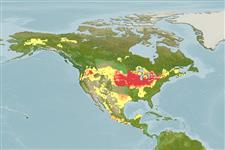Classification / Names
Common names from other countries
Main reference
Size / Weight / Age
Max length : 66.0 cm TL male/unsexed; (Ref. 40637); common length : 26.6 cm TL male/unsexed; (Ref. 12193); max. published weight: 3.6 kg (Ref. 4699); max. reported age: 10 years (Ref. 12193)
Environment
Freshwater; demersal; pH range: 6.5 - 8.0; dH range: 4 - 25; amphidromous (Ref. 51243); depth range 10 - ? m
Climate / Range
Temperate; 8°C - 30°C (Ref. 2059), preferred ?; 52°N - 26°N
Distribution
North America: Great Lakes to northern Mexico. Confusion over the taxonomic status of this species together with Ameiurus nebulosus resulted in more doubts as to which of the two is present in some countries. In Europe it forms dense stunted populations which makes it unpopular. Several countries report adverse ecological impact after introduction (Ref. 1739). In Europe, self-sustaining populations recorded from Ebro and Tagus drainages (Iberian Peninsula), most drainages of France, locally in Italy, the Netherlands and Germany; distribution coud be wider (Ref. 59043)
Countries | FAO areas | Ecosystems | Occurrences | Introductions
IUCN Red List Status (Ref. 115185)
Threat to humans
Potential pest
Human uses
Fisheries: commercial; aquaculture: commercial; gamefish: yes
More information
ReferencesAquacultureAquaculture profileStrainsGeneticsAllele frequenciesHeritabilityDiseasesProcessingMass conversion
Tools
Special reports
Download XML
Internet sources
Estimates of some properties based on models
Phylogenetic diversity index
PD50 = 0.5078 many relatives (e.g. carps) 0.5 - 2.0 few relatives (e.g. lungfishes)
Trophic Level
3.8 ±0.4 se; Based on diet studies.
Resilience
Medium, minimum population doubling time 1.4 - 4.4 years (tmax=10; Assuming tm=3)
Vulnerability
Moderate to high vulnerability (50 of 100)
Price category
